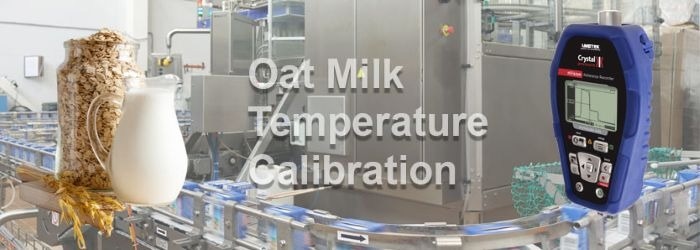Oat Milk Temperature Calibration

Image Credit: Lloyd Instruments Ltd.
Oat milk is an increasingly popular alternative to dairy milk. To meet global demand, a growing number of manufacturers are coming into the oat milk market. However, producing this dairy-free alternative is a somewhat convoluted process, requiring multiple steps such as soaking, blending, filtering, and pasteurization. An important factor that affects both the quality and safety of the product is its process temperature.
Pasteurization is a crucial step in the production of oat milk. It requires milk to be heated to a certain temperature for a certain amount of time to kill off dangerous bacteria and increase shelf life.
Oat milk’s usual temperature range for pasteurization is between 72 °C (162 °F) and 85 °C (185 °F), varying according to the processes and equipment used. It’s essential to track the temperature throughout the pasteurization process to make sure that the milk is heated to the appropriate temperature and maintained for a suitable amount of time.
Manufacturers need to be able to accurately assess and record process temperatures to ensure the safety and quality of their oat milk. This can be done by integrating instruments into different equipment parts, such as the pasteurizer, holding tank, and packaging line.
By tracking and recording temperatures instantaneously, manufacturers can ensure that pasteurization is effective and that the milk is safe to consume.
Risk of contamination is a key issue confronting manufacturers when they use temperature sensors in the production of oat milk. If the sensors are not adequately protected, they can become a hub for harmful bacteria.
To prevent this, manufacturers must use sanitary sensors that resist high temperatures and are made from easy-to-clean, sterilizable materials.
Sanitary sensors are critical for prolonging oat milk’s quality and safety. They help stave off contamination while ensuring accurate temperature readings, as well as protecting instruments under testing from elevated process temperatures.
AMETEK’s Solution
The Crystal Engineering nVision Reference Recorder is a portable yet rigorous tool that is ideal for live assessment and recording of temperature data. The nVision Reference Recorder with an RTD100 temperature module and a temperature probe that can assess temperatures in the pasteurizer, holding tank, and packaging line.
If a record of the test is needed, the nVision has a recording feature that can store up to one million data points, gathering as many as ten readings per second. This makes subsequent downloading of the stored data to a spreadsheet a simple task.
The AMETEK sanitary tri-clamp and STA-Kool cooling tower are built into the setup to safeguard the nVision from the process media temperature and the oat milk from contamination.
In conclusion, logging process temperatures is essential in oat milk manufacturing. By carefully monitoring and recording temperatures throughout production, manufacturers can ensure effective pasteurization, helping to guarantee the final product is safe for consumption and meets quality standards.
To read a PDF copy of this article, please click here
For further information regarding the nVision, please visit AMETEK’s nVision webpage here.

This information has been sourced, reviewed, and adapted from materials provided by AMETEK - Crystal Engineering.
For more information on this source, please visit AMETEK - Crystal Engineering.